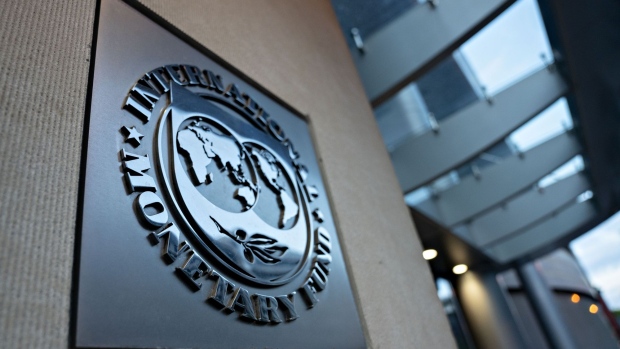Oct 13, 2020
IMF sees shallower recession, tough path back to recovery
, Bloomberg News

The International Monetary Fund warned that the world economy still faces an uneven recovery until the coronavirus is tamed even as it offered a less-dire view of this year’s recession following massive stimulus from central banks and governments.
The fund now forecasts world gross domestic product to shrink 4.4% this year, compared with the 5.2% drop seen in June, according to the latest World Economic Outlook released Tuesday. For 2021, the IMF sees growth of 5.2%, down from 5.4%. The report includes revisions to June’s forecasts and other historical data to reflect updated country weightings.
The contraction would still be the deepest since the Great Depression, with Covid-19 having killed more than 1 million people and shut down large swaths of business. The report sets the tone for this week’s annual meetings of the IMF and World Bank -- being held virtually, like April’s spring meetings, due to the pandemic -- as global policy makers discuss how to avert a wave of debt defaults in poorer nations resulting from the virus’s impact.
Extreme poverty is set to rise for the first time in more than two decades, and persistent output losses imply a major setback to living standards versus the pre-pandemic days, the IMF said. Most economies are expected to experience lasting damage to supply potential and scars from the deep recession.
“This is going to be slow. This why we describe this as a long, uneven, and uncertain ascent,” IMF chief economist Gita Gopinath said Tuesday in a Bloomberg Television interview. “You are seeing low-skilled workers, youth, women, doing worse in labor markets, so we see rising inequality and the poor are getting poorer.”
Gopinath warned that nations should not yet withdraw support. The impact of the downturn has been cushioned by policy initiatives, including a European pandemic-recovery package, and large-scale central bank asset purchases, the fund said. Such unprecedented support helped ease financial conditions since June in advanced economies and in most emerging and developing economies.
Policy makers must avoid prematurely withdrawing support in order to avoid setbacks, Gopinath said. The forecasts assume monetary policy is maintained at current settings through 2025, helping to alleviate debt service burdens for many countries. Governments globally have implemented $6 trillion in direct tax and spending measures, according to the IMF.
The fund’s forecast is based on the expectation that social distancing will continue into next year but gradually fade over time as vaccine coverage expands. It also is premised upon local transmission of the virus being brought to low levels everywhere by the end of 2022.
The upward revision in the IMF’s 2020 growth forecast reflects in particular better-than-projected second-quarter growth in the U.S. and the euro area, a stronger-than-anticipated return to growth in China and signs of a more rapid recovery in the third quarter.
The U.S. economy is projected to contract 4.3 per cent this year, compared with a previous eight per cent estimate, the most-improved forecast among major economies. That doesn’t factor in potential additional fiscal stimulus, though, as President Donald Trump and Democrats continue to wrangle over measures. Growth is pegged at 3.1 per cent in 2021, down from a prior forecast of 4.5 per cent.
The euro area is estimated to shrink 8.3 per cent this year, compared with the previous 10.2 per cent projection, before expanding 5.2 per cent in 2021, down from 6%. Advanced economies overall are seen declining 5.8 per cent in 2020, compared with 8.1 per cent previously.
By contrast, the outlook for emerging markets, some with rising infections, has worsened slightly, with a 3.3 per cent contraction anticipated for this year, compared with 3.1 per cent previously.
China remains the lone major economy estimated to expand, with 1.9 per cent projected growth this year and an 8.2 per cent boom in 2021. India saw the steepest forecast reduction, with a 10.3 per cent contraction seen for this year, compared with just 4.5 per cent previously, after a larger-than expected second-quarter contraction.
Overall, the fund sees global output by the end of 2021 being 0.6 per cent higher than at the end of 2019, before the pandemic, but that’s driven almost entirely by China. Most other nations, including the U.S., will need to wait until at least 2022 to see full recovery to pre-virus levels.
The subdued outlook for medium-term growth will be accompanied by a significant increase in sovereign debt -- by about 20 percentage points in advanced economies to 125 per cent of GDP by the end of 2021, and by more than 10 percentage points in emerging and developing economies to 65 per cent of GDP, according to IMF estimates.
Were the recession caused by the pandemic to deepen, a US$130 billion capital hole in the global banking system could result, the IMF said in its semi-annual report on financial stability issued Tuesday alongside the global economic forecasts. Most of the shortfall would be in emerging-market firms, while the lenders considered systemically important by regulators would fare better than the rest, the fund said.
--With assistance from Zoe Schneeweiss, Jeff Kearns and Sarina Yoo.
